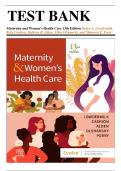Maternity by lowdermilk - Study guides, Class notes & Summaries
Looking for the best study guides, study notes and summaries about Maternity by lowdermilk? On this page you'll find 798 study documents about Maternity by lowdermilk.
Page 3 out of 798 results
Sort by
Test bank - Maternity and Women's Health Care, 13th Edition by Deitra L. Lowdermilk, Kitty Cashion, Kathryn R. Alden, Ellen Olshansky, and Shannon E. Perry
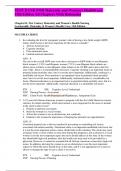
-
TEST BANK FOR Maternity and Women's HealthCare 13th Edition All Chapters With Rationales
- Exam (elaborations) • 362 pages • 2024
-
Available in package deal
-
- $13.99
- 2x sold
- + learn more
TEST BANK FOR Maternity and Women's HealthCare 13th Edition All Chapters With Rationales Chapter 01: 21st Century Maternity and Women’s Health Nursing Lowdermilk: Maternity & Women’s Health Care, 12th Edition MULTIPLE CHOICE 1. In evaluating the level of a pregnant woman’s risk of having a low-birth-weight (LBW) infant, which factor is the most important for the nurse to consider? a. African-American race b. Cigarette smoking c. Poor nutritional status d. Limited maternal educat...
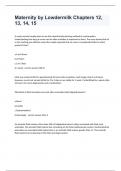
-
Maternity by Lowdermilk Chapters 12, 13, 14, 15 exam questions and complete correct answers 2024
- Exam (elaborations) • 45 pages • 2024
-
- $14.99
- + learn more
A newly married couple plans to use the natural family planning method of contraception. Understanding how long an ovum can live after ovulation is important to them. The nurse knows that his or her teaching was effective when the couple responds that an ovum is considered fertile for which period of time? a.6 to 8 hours b.24 hours c.2 to 3 days d.1 week - correct answer ANS: B Most ova remain fertile for approximately 24 hours after ovulation, much longer than 6 to 8 hours. However, ov...
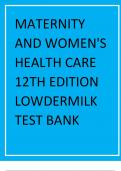
-
TEST BANK FOR MATERNITY AND WOMEN'S HEALTH CARE 12TH EDITION LOWDERMILK .pdf
- Exam (elaborations) • 618 pages • 2023
-
- $25.49
- 1x sold
- + learn more
The "Test Bank for Maternity and Women's Health Care, 12th Edition" by Lowdermilk is an essential resource for nursing students and educators focused on maternal and women's health. Here’s a detailed overview of what this test bank provides: Overview Comprehensive Coverage: This test bank includes questions for all chapters of the 12th edition, ensuring complete alignment with the textbook and covering all essential topics in maternity and women’s health care. Key Features Variety of Q...

-
Week 1: Maternity by Lowdermilk & Perry: Chapters 1, 2 exam questions and 100% correct answers 2024
- Exam (elaborations) • 36 pages • 2024
-
- $15.49
- + learn more
Chapter 01: 21st Century Maternity and Women's Health 1. To assess a mother's risk of having a low-birth-weight (LBW) infant, what is the most important factor for the nurse to consider? a. African-American race b. Cigarette smoking c. Poor nutritional status d. Limited maternal education - correct answer ANS: A For African-American births, the incidence of LBW infants is twice that of Caucasian births. Race is a nonmodifiable risk factor. Cigarette smoking is an important ...
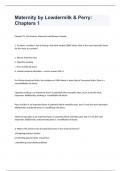
-
Maternity by Lowdermilk & Perry: Chapters 1 exam questions and verified correct answers 2024
- Exam (elaborations) • 19 pages • 2024
-
- $14.99
- + learn more
Chapter 01: 21st Century Maternity and Women's Health 1. To assess a mother's risk of having a low-birth-weight (LBW) infant, what is the most important factor for the nurse to consider? a. African-American race b. Cigarette smoking c. Poor nutritional status d. Limited maternal education - correct answer ANS: A For African-American births, the incidence of LBW infants is twice that of Caucasian births. Race is a nonmodifiable risk factor. Cigarette smoking is an important ...
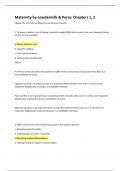
-
Maternity by Lowdermilk & Perry: Chapters 1, 2 (100% Guaranteed)
- Exam (elaborations) • 41 pages • 2024
-
- $12.99
- + learn more
Chapter 01: 21st Century Maternity and Women's Health 1. To assess a mother's risk of having a low-birth-weight (LBW) infant, what is the most important factor for the nurse to consider? a. African-American race b. Cigarette smoking c. Poor nutritional status d. Limited maternal education ANS: A For African-American births, the incidence of LBW infants is twice that of Caucasian births. Race is a nonmodifiable risk factor. Cigarette smoking is an important factor in potential infant ...
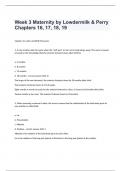
-
Week 3 Maternity by Lowdermilk & Perry Chapters 16, 17, 18, 19 exam questions and verified correct answers 2024
- Exam (elaborations) • 75 pages • 2024
-
- $14.99
- + learn more
Chapter 16. Labor and Birth Processes 1. A new mother asks the nurse when the "soft spot" on her son's head will go away. The nurse's answer is based on the knowledge that the anterior fontanel closes after birth by: a. 2 months b. 8 months c. 12 months d. 18 months - correct answer ANS: D The larger of the two fontanels, the anterior fontanel closes by 18 months after birth. The posterior fontanel closes at 6 to 8 weeks. Eight months is much too early for the anterior fontanel t...
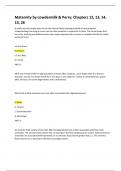
-
Maternity by Lowdermilk & Perry: Chapters 12, 13, 14, 15, 26 Download To Score A+
- Exam (elaborations) • 82 pages • 2024
-
- $12.49
- + learn more
A newly married couple plans to use the natural family planning method of contraception. Understanding how long an ovum can live after ovulation is important to them. The nurse knows that his or her teaching was effective when the couple responds that an ovum is considered fertile for which period of time? a.6 to 8 hours b.24 hours c.2 to 3 days d.1 week ANS: B Most ova remain fertile for approximately 24 hours after ovulation, much longer than 6 to 8 hours. However, ova do not remain ...
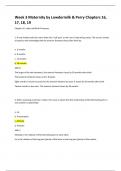
-
Week 3 Maternity by Lowdermilk & Perry Chapters 16, 17, 18, 19 Top Solution Rated A+
- Exam (elaborations) • 86 pages • 2024
-
- $13.19
- + learn more
Chapter 16. Labor and Birth Processes 1. A new mother asks the nurse when the "soft spot" on her son's head will go away. The nurse's answer is based on the knowledge that the anterior fontanel closes after birth by: a. 2 months b. 8 months c. 12 months d. 18 months ANS: D The larger of the two fontanels, the anterior fontanel closes by 18 months after birth. The posterior fontanel closes at 6 to 8 weeks. Eight months is much too early for the anterior fontanel to close. It closes ...

That summary you just bought made someone very happy. Also get paid weekly? Sell your study resources on Stuvia! Discover all about earning on Stuvia

